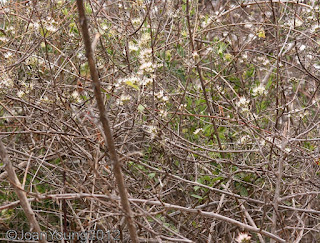Family Combretaceae
Masses of lovely fluffy pink-white flowers are displayed on bare branches in early spring. Fragrant and resembling small powder puffs, they lure a variety of pollinating insects.Description
The deciduous knobbly creeper has long trailing branches and usually easily scrambles into surrounding bush, where its flowers can be seen to advantage. However, it may also form either a shrub or small tree (3-4 m high, 3 m wide). Flowers appear from August to November (spring to summer), and are followed by five, or sometimes four, winged fruits that are tinged pink for a while before ripening to brown and papery in summer (October to January). The grey to brownish bark is smooth.
Natural distribution
This species is found in low-lying bushveld and thicket in hot, dry areas, on hills (koppies) and often near rivers in South Africa, Zimbabwe, Mozambique, Botswana, Namibia and northwards into the dry, hot parts of tropical Africa.
Ecology
Most browsers enjoy feeding on this Combretum, and the larvae of the Striped Policeman and Guinea-fowl butterflies feed on the leaves. The flowers draw insects, in turn attracting insect-eating birds such as the Brownheaded Kingfisher.
Uses and cultural aspects
Roots and leaves of C. mossambicense and Acalypha villicaulis are crushed and boiled in plenty of water. The extract is used to steam the face to reduce swelling caused by a tooth abscess, or for eye inflammation. Hot compresses are made from the dregs. The extract is also used for gargling or eye baths, or it is tossed onto red-hot coals and the steam is used to ease swollen body parts. The liquid can be rubbed into small scratches over swellings.





